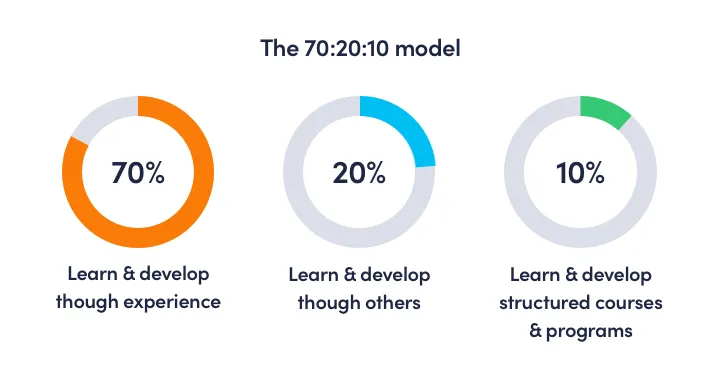The concept of social learning platforms has emerged as a beacon of collaborative knowledge acquisition. These platforms leverage the power of community and technology to enhance learning through shared experiences and peer-to-peer interaction. As the demand for more interactive and accessible learning solutions grows, the opportunity to create a successful social learning platform becomes increasingly viable.
According to a 2023 report by the Global Education Market, the online learning platform market is projected to grow by 28% annually, reaching an estimated value of $66,7 billion by 2028. This underscores the increasing shift towards digital education solutions.
Having effective and engaging learning experiences that amplify the success of the organization’s learning strategy is crucial. Are you thinking about building your own social learning platform? You are in the right place, keep reading.
What will you learn from this article?:
- Understanding the concept and value of social learning,
- What are the 10 essential features of a Social Learning System?
- How to build a social network app or platform for learning?
- How should we identify the target audience while creating a social learning platform?
- How should we ensure platform scalability and sustainability while creating the platform?
What is Social Learning - Concept and Value?
Social and collaborative learning may be one of humankind’s oldest form of learning. In psychology, the basis of the social learning theory is simple: people learn by watching other people. We observe the behaviour and we mimic it.
Social learning transcends traditional educational boundaries, transforming every learner into both a teacher and a student. This reciprocity not only enriches knowledge but also builds a vibrant community where shared understanding and collaboration fuel collective growth.
In recent years, the definition of social learning has been redefined to fit into the work environment. In a business context, social learning is defined by the informal ways that we learn from colleagues, in particular, through social technologies like discussion forums, videos, wikis or blogs. Businesses that support social learning have environments that foster collaboration and conversation between learners across the organization.
Why is a Social Learning Platform so Important?
According to the 70-20-10 model of learning and development, individuals obtain 70% of knowledge from job-related experiences, 20% from interaction with others and 10% from educational events. The model is considered the greatest value as a general guideline for organizations wanting to maximize the effectiveness of their learning and it continues to be adopted by many businesses throughout the world.

Integrating social learning in the learning strategy has benefits for both learners as well as the business. It can improve the learning experience and result in a positive outcome in terms of learning success and a positive return of investment.
Benefits for learners
- learner-centric: social learning appeals to the learner because it is learner-centric and allows them to take responsibility for their personal learning.
- modern approach: social learning is especially liked by the younger staff (those who are entering the modern workforce).
- flexibility: social learning offers support to formal means of learning and is flexible in their application.
- fosters collaboration: social learning enhances corporate culture and allows learners to be supported by other learners.
Benefits for businesses
- learner engagement
- effective collaboration
- encourages self-organization
Social learning empowers learners. At times, all it takes is to consult a colleague in order to refocus and get the job faster. Collaboration and interaction help to learn better.
What is more, the ratio between social learning approaches and web-based training is 75:1 - which is a huge advantage for the former.
Try our developers.
Free for 2 weeks.
No risk. Just results. Get a feel for our process, speed, and quality — work with our developers for a trial sprint and see why global companies choose Selleo.
10 Must-Have Social Learning System Features
With the right features, your social learning platform will become a super learning platform. Let’s talk about a few of them.
- 1. User Profiles: Personalised profiles where learners can share their academic interests, skills, and learning goals. This enhances the sense of community and facilitates tailored learning experiences.
- 2. Interactive Content Tools: Tools that enable the creation and sharing of interactive content such as videos, quizzes, and simulations. These features support varied learning styles and keep users engaged.
- 3. Discussion Forums and Chat Rooms: Spaces for learners to discuss topics, ask questions, and exchange ideas. This promotes peer-to-peer learning and helps build a supportive learning community.
- 4. Collaborative Workspaces: Features like shared documents, whiteboards, and project management tools that allow users to work together on projects and assignments in real-time.
- 5. Gamification Elements: Incorporating elements such as points, badges, and leaderboards to motivate and engage learners by adding a competitive element to the learning process.
- 6. Personalised Learning Paths: Algorithms that suggest content and activities based on the user's past activities and preferences. This helps to create a more personalised learning experience that adapts to the individual’s pace and interests.
- 7. Social Learning Tools for Analytics and Reporting: Features that allow educators and learners to track progress through detailed reports and analytics. These tools help in identifying strengths and areas for improvement.
- 8. Mobile Compatibility: Ensuring the platform is accessible on various devices, particularly smartphones and tablets, to allow learning on-the-go.
- 9. Social Media Integration: Enabling users to connect their learning accounts with social media platforms to facilitate sharing achievements and learning milestones, which can also help in community building.
- 10 Multi-Language Support: Providing content in multiple languages to cater to a global audience and enhance the inclusivity of the platform.
How to Build a Successful Social Learning Platform
Designing a social learning platform that works well, attracts and retains users is not an easy task. Outsourcing your software development may help you ensure your solution is a success, but there are also some steps you can take yourself.
1. Identifying the target audience - Speak to your potential users
Before you launch your social learning platform it is crucial to think about what your users need. Understanding the specific needs, preferences, and characteristics of potential users can significantly influence the platform’s structure, content, and features.Talk to the people in your community, ask them about their challenges and what would benefit them. Here's how to analyse and understand these needs through demographic and psychographic profiling:
Steps to Analyse and Understand the Needs of Potential Platform Users:
Conduct Market Research: Start by gathering data through surveys, focus groups, and interviews to understand the characteristics, needs, and behaviours of potential users. This can include educators, students, professionals, and anyone interested in continuous learning.
Understanding our users begins with comprehensive market research. By listening to their needs through surveys and interviews, we craft a platform that truly resonates with them.
Segment the Audience: Divide the audience into segments based on age, educational level, profession, or other relevant demographics. This helps in tailoring the platform to meet the specific needs of each group.
Segmentation is critical. It allows us to tailor our educational content and tools to meet the distinct needs of different learner groups effectively.
Analyse Learning Behaviours: Understand how different groups prefer to learn. For instance, younger audiences might prefer interactive and visual content, whereas professionals might seek more in-depth, text-based materials.
Every learner has a unique approach to acquiring knowledge. Analysing these behaviours helps us develop functionalities that cater to diverse learning preferences.
Identify Technological Proficiency: Assess the technological skills of the target audience to determine the complexity of the platform's interface. Younger or more tech-savvy groups might benefit from advanced features, while others may require a more straightforward, easy-to-navigate design.
Platform design must reflect the technological proficiency of our users. It’s about making powerful tools accessible and usable for everyone, from tech novices to experts.
Evaluate Motivations for Learning: Discover what drives each segment to learn. Some might seek career advancement, while others could be motivated by personal development or social interaction.
Recognising what motivates our users to learn is key to engaging them. Whether it’s career progression or personal growth, understanding these motivations shapes content strategy.
How Demographic and Psychographic Profiling Shapes Platform Design
Demographic Profiling - This involves understanding the age, education, location, and profession of your audience. This data can determine:
- Content Type: Choosing appropriate complexity and depth of content.
- Interface Design: Designing an interface that accommodates the technological familiarity and preferences of different age groups.
- Accessibility Options: Including features that cater to various educational backgrounds and physical abilities.
Psychographic Profiling - This focuses on the psychological attributes of your audience, such as personality, values, and interests. Insights from psychographic profiling can influence:
- Personalisation Features: Developing features that cater to the personal preferences and learning styles identified through profiling.
- Community Engagement: Creating community features and group activities that align with the users' values and interests.
- Motivational Elements: Integrating gamification and rewards that resonate with what motivates the audience to learn and engage.
By combining demographic and psychographic data, you can design a social learning platform that not only meets the educational needs of its users but also creates an engaging and supportive community environment. This tailored approach ensures that the platform is useful, appealing, and sustainable.
2. Start with an MVP
Starting small ensures you can test your product on a smaller scale and improve your platform before the full launch. This feedback will help you find bugs, find out what works, giving you the best chance of success. What is more, the early group will create some activity on your platform so you will not be starting from scratch.
3. New content

Although starting with a platform with lots of resources is good, it will quickly become boring if there is no new content. That is why it is super important to upload new resources regularly. Encourage user-generated content like a community blog or a forum. People enjoy learning from their peers so the more user content added the better.
4. Encourage participation
Until your social learning platform builds a solid community, you may need a strategy to encourage people to use it. Think about ways to invite people: through exclusive content, digital certificates, discounts etc.
5. Marketing
Building a community is just the beginning. A good marketing strategy including email marketing, social media promotion, SEO optimization, content marketing or advertising is key. If your platform is targeted at a particular, smaller group, consider using direct email with your personal contacts.
6. Analytics
Keep an eye on your learning analytics. Find out which activities your users are completing, how much time they are spending on the platform, bounce rates etc. These analytics will help you understand how to further improve your platform.

Why is it Important to Ensuring Platform Scalability and Sustainability?
Ensuring the scalability and sustainability of a social learning platform is essential for its long-term success and growth. This involves careful planning in both technical architecture and business strategy. Below are key considerations for achieving scalability and sustainability:
Ensuring scalability and sustainability isn't just about handling growth—it's about delivering consistent, reliable learning experiences at every stage of our platform's evolution.
Technical Considerations for Scaling the Social Learning Software
- Cloud-Based Infrastructure: Adopt a cloud-based solution to facilitate easy scaling of resources in response to fluctuating demand. This allows for the addition of more storage and processing power without physical hardware constraints.
- Microservices Architecture: Implement a microservices architecture to make the platform more flexible and easier to manage. This approach allows different parts of the application to scale independently, improving performance and reducing downtime.
- Efficient Data Management: Optimize data storage and retrieval processes to handle increased loads. Use database solutions that can scale horizontally, and implement effective data caching to enhance speed and reduce latency.
- Load Balancing: Use load balancers to distribute user requests across multiple servers, ensuring no single server bears too much load, which can help maintain performance during peak usage times.
- Continuous Monitoring and Testing: Regularly monitor the platform's performance and conduct load testing to identify potential bottlenecks before they affect users. This proactive approach helps in making necessary adjustments timely.
Summary
Social learning is one of the oldest methods of knowledge acquisition. People learn through observing others’ behaviours and attitudes Educational institutions and other business are embracing the power of social learning and are creating platforms that encourage it.
Social learning LMS serves as a platform for organizations to share knowledge while ensuring that the employees are given the desired training.
If you are looking for more information on building your own LMS, go to Why Build Your Own Corporate LMS.





